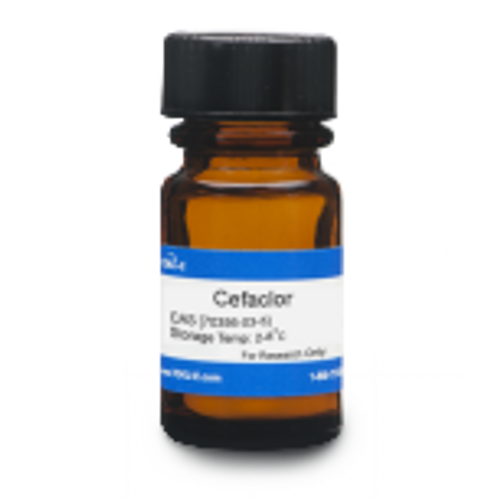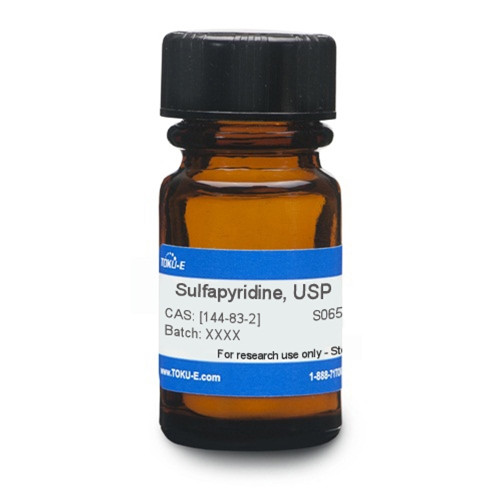Cefaclor is a second generation cephalosporin antibiotic derived from the Acremonium fungus. It can be used to study the bacteria causing urinary tract and Haemophilus influenzae infections. The compound can also be used to study the effects of the inhibition of penicillin-binding proteins on bacterial cell wall mucopeptide synthesis (ref). Cefaclor is also used for vitro microbiological antimicrobial susceptibility testing.
| Mechanism of Action | Like β-lactams, cephalosporins interfere with PBP (penicillin binding protein) activity involved in the final phase of peptidoglycan synthesis. PBP’s are enzymes which catalyze a pentaglycine crosslink between alanine and lysine residues providing additional strength to the cell wall. Without a pentaglycine crosslink, the integrity of the cell wall is severely compromised and ultimately leads to cell lysis and death. Resistance to cephalosporins is commonly due to cells containing plasmid encoded β-lactamases. |
| Spectrum | Cefaclor is a broad spectrum antibiotic against Gram-negative and Gram-positive bacteria, including those that cause pneumonia and meningitis such as Streptococcus pneumoniae and Haemophilus influenzae |
| Microbiology Applications | Cefaclor is commonly used in clinical in vitro microbiological antimicrobial susceptibility tests (panels, discs, and MIC strips) against gram positive and gram negative microbial isolates. Medical microbiologists use AST results to recommend antibiotic treatment options. Representative MIC values include:
|
| Eukaryotic Cell Culture Applications | The interaction of Cefaclor with three human renal transporters (human organic anion transporter 1 (hOAT1), human peptide transporter 1 (hPepT1), and human peptide transporter 2 (hPepT2)) was studied.. Madin-Darby canine kidney cell lines expressing these transporters were established. Cefaclor was found to be transported by hPepT1 and hPepT2. (Li et al, 2006) |
| Molecular Formula | C15H14ClN3O4S • H2O |
| Impurities | Individual impurities: ≤0.5% Total impurities: ≤2.0% |
| References |
Georgopapadakou, NH (1992) Mechanisms of Action of Cephalosporin 3'-quinolone Esters, Carbamates, and Tertiary Amines in Escherichia Coli. 37(3):559-565. Antimicrob. Agents and Chemother. 37(3):559-565 Picard M and Malouin F (1992) Molecular basis of the efficacy of Cefaclor against Haemophilus influenzae. Antimicrob. Agents Chemother. 36(11):2569-2572 PMID 1489208 |
| MIC | Bacillus pumilus| 8|| Bacteroides bivius| 8 - 32|| Bacteroides disiens| 8|| Bacteroides distasonis| 8 - 32|| Bacteroides fragilis| 64 - >128|| Bacteroides melaninogenicus| >32|| Bacteroides ovatus| 8 - >32|| Bacteroides thetaiotaomicron| 8 - >32|| Bacteroides vulgatus| 8 - >32|| Borrelia afzelii| 8 - 16|| Borrelia bissettii (25015)| 8|| Borrelia burgdorferi| 4 - 128|| Borrelia garinii| 4 - 8|| Borrelia valaisiana| 16|| Branhamella catarrhalis| 0.03 - 2.5|| Brucella abortus| 4|| Brucella melitensis| 4|| Brucella suis| 4|| Citrobacter amalonaticus| 11720|| Citrobacter diversus| 0.5 - 8|| Citrobacter freundii| 0.5 - >64|| Citrobacter spp.| 8 - >128|| Clostridium bifermentans| 32|| Clostridium difficile| 32 - >64|| Clostridium histolyticum | 8 - 32|| Clostridium perfringens| 8 - 32|| Clostridium ramosum| 32|| Clostridium sordellii| 8 - 32|| Clostridium sporogenes| 8 - 32|| Clostridium spp.| 32|| Edwardsiella hoshinae | 0.13|| Edwardsiella ictaluri | 0.13 - 4|| Edwardsiella tarda| 0.13 - 8|| Enterobacter aerogenes| 1 - >64|| Enterobacter agglomerans| 0.5 - >32|| Enterobacter cloacae| 2 - >64|| Enterobacter sakazakii| 1 - 16|| Enterobacter spp.| 16 - >128|| Enterococci| 32|| Enterococcus| >32|| Enterococcus faecalis| 16 - >32|| Enterococcus faecium| >64|| Enterococcus liquefaciens | 16 - 64|| Enterococcus spp.| 2 - >32|| Escherichia coli| 0.25 - >128|| Haemophilus influenzae| 0.03 - 128|| Haemophilus parainfluenzae| 4 - 16|| Haemophilus spp.| 0.5 - 128|| Hafnia alvei| 8 - 16|| Helicobacter pylori| 0.004 - 50|| Hernia alvei| >32|| Klebsiella oxytoca| 0.25 - 1|| Klebsiella pneumonia| 0.5 - 32|| Klebsiella spp.| 0.5 - >128|| Kluyvera spp.| >32|| Listeria innocua| 16 - >64|| Listeria ivanovii| 16 - >64|| Listeria monocytogenes| 16 - >64|| Listeria seeligeri| 16 - >64|| Listeria welshimeri| 16 - >64|| Moraxella catarrhalis| ≤0.03 - 32|| Morganella morganii| 1 - >128|| Neisseria gonorrhoeae| 0.015 - 125|| Neisseria meningitidis| 0.06|| Pasteurella multocida| <8 || Peptococcus asaccharolyticus| 32|| Peptostreptococcus anaerobius| 32|| Pneumococci| 32|| Proteus mirabilis| 0.25 - 64|| Proteus vulgaris| 0.12 - >128|| Providencia alcalifaciens| >32|| Providencia rettgeri| 0.25 - >64|| Providencia spp.| 1 - >128|| Providencia stuartii| 4 - >64|| Pseudomonas aeruginosa| >32 - 128|| Pseudomonas cepacia| 32 - >64|| Pseudomonas flourescens| 32 - >64|| Pseudomonas putida| 32 - >64|| Pseudomonas spp.| >32|| Pseudomonas stutzeri| >6 - >64|| Salmonella Agona| 0.13 - 0.5|| Salmonella Brandenburg| 0.13 - 0.5|| Salmonella Enteritidis| 0.13 - 32|| Salmonella spp.| 0.5 - 64|| Salmonella typhimurium| 0.13 - 25|| Serratia liquefaciens| 16 - >64|| Serratia marcescens| 16 - >128|| Serratia spp.| 32 - >128|| Shigella boydii| 1 - 2|| Shigella flexneri| 1 - >32|| Shigella sonnei| 1 - >32|| Shigella spp.| 0.5 - 32|| Staphylococcus aeruginosa (ATCC 29213)| 2|| Staphylococcus aureus| 0.6 - 128|| Staphylococcus cohnii| 0.25 - 8|| Staphylococcus epidermidis| 0.25 - 64|| Staphylococcus haemolyticus (methicillin-resistant)| 0.25 - >64|| Staphylococcus hominis| 0.5 - 4|| Staphylococcus pseudintermedius| 0.12 - 4|| Staphylococcus saprophyticus| 0.25 - >64|| Staphylococcus simulans| 0.5 - 2|| Staphylococcus spp. (coagulase-negative)| ≤0.12 - >32|| Staphylococcus warneri| 1 - 4|| Stenotrophomonas maltophilia| 32|| Streptococcus agalactiae| 0.5 - 4|| Streptococcus milleri| 2 - 16|| Streptococcus mitior| 2 - 16|| Streptococcus pyogenes| 0.06 - 4|| Xanthomonas maltophilia| ≤0.12 - >64|| Yersinia enterocolitica| 0.25 - >128|| |








